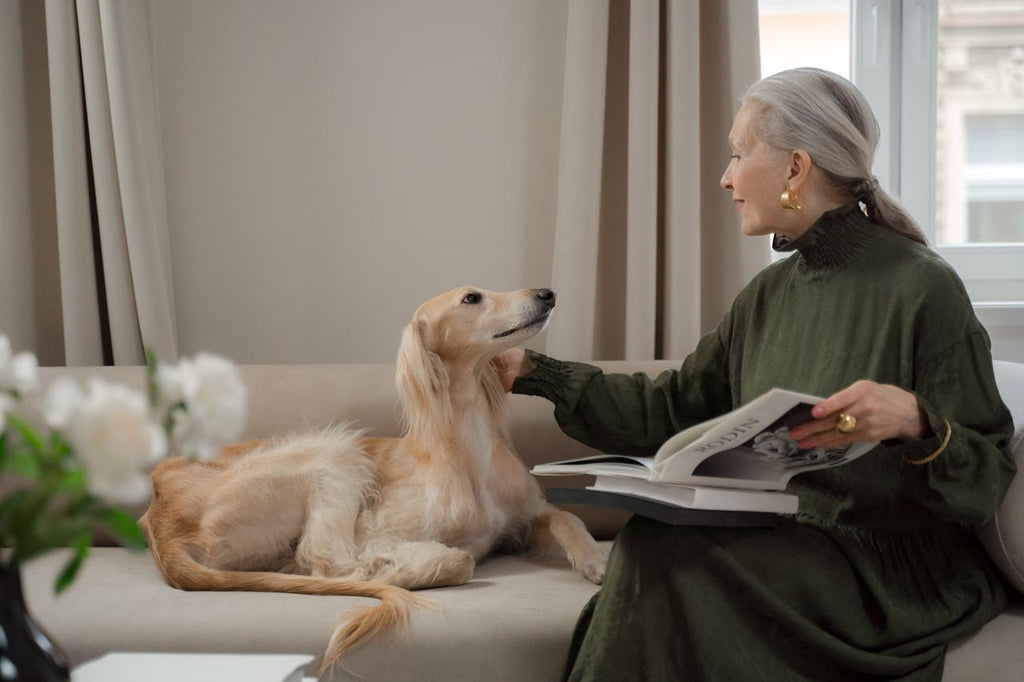
Dog Ears Back: Decoding Canine Signals

Understanding and interpreting your dog's body language is crucial for effective communication and bonding. In this article, we will delve into the various signals that dogs use to communicate their feelings and intentions.
Key Takeaways
- Pay attention to your dog's ear positions to gauge their mood and emotions.
- Tail wagging can indicate different emotions depending on the speed and direction.
- Facial expressions, such as relaxed or tense features, can reveal your dog's state of mind.
- Establishing eye contact with your dog can strengthen your bond and convey trust.
- Using consistent vocal cues helps your dog understand commands and signals effectively.
Understanding Dog Body Language
Interpreting Ear Positions
When trying to understand what your dog is communicating, paying attention to their ear positions is crucial. Dogs have a wide range of ear movements, each signifying different emotions or intentions. Ears that are held erect and forward usually indicate that your dog is alert and focusing on something. This could be a sign of interest or curiosity about their environment.
On the other hand, if your dog's ears are pinned back against their head, it could be a sign of fear, anxiety, or submission. It's important to consider the context of the situation to accurately interpret this signal. For example, if there's a loud noise or a new person in the room, your dog might be feeling scared or nervous.
Here are a few key ear positions to watch for:
- Ears up and forward: Alertness or interest
- Ears flattened: Fear, anxiety, or submission
- Ears twitching: Trying to pinpoint a sound or direction
- Ears relaxed and to the side: Comfort and contentment
Remember, while ear positions can give you valuable insights, they are just one piece of the puzzle. Always look at the full picture of your dog's body language to understand their feelings and intentions.
Deciphering Tail Wagging
While observing your dog's tail, it's crucial to note that a wagging tail doesn't always equate to happiness. The tail's position, movement, and speed can convey a wide range of emotions and intentions. Here are some key points to consider:
- A tail held high and wagging rapidly may indicate excitement or alertness.
- A tail that is wagging slowly and at half-mast could be a sign of insecurity or a tentative greeting.
- When a dog's tail is tucked under its body, it's often a signal of fear or submission.
Understanding these nuances can help you better interpret what your dog is trying to communicate. Remember, tail wagging is just one piece of the complex puzzle of canine body language. To fully understand your furry friend, pay attention to their overall posture, ear positions, and facial expressions. And when it comes to grooming and care, consider products that are gentle on your pet's skin and fur. Look for options that are sulfate-free, paraben-free, and cruelty-free, ensuring a happy and healthy companion.
You may also like: Exploring Why Your Dog's Tail Wags During Sleep
Reading Facial Expressions
Beyond the wag of a tail or the position of the ears, your dog's facial expressions can provide valuable insights into their emotional state. Observe the subtleties of your dog's eyes, mouth, and even the tension in their forehead to better understand their feelings and intentions.
- Relaxed, slightly open mouths often indicate a content and happy dog.
- A furrowed brow or hard stare can signal concentration or, in some cases, growing agitation.
- Soft eyes and a gentle gaze typically suggest trust and affection.
Remember, consistency in your observations will help you become more attuned to your dog's unique ways of expressing themselves. If you're ever unsure about what your dog is trying to communicate, consider the context of the situation and look for other body language cues.
Communicating with Your Canine Companion
Establishing Eye Contact
After you've learned to interpret your dog's body language, it's time to focus on how you can communicate effectively with them. One of the most powerful tools at your disposal is eye contact. Establishing eye contact with your dog can create a deeper connection and is essential for effective training. However, it's important to approach this step correctly to avoid intimidating your dog.
Start by sitting at your dog's level to make the experience less threatening. Offer a treat to encourage your dog to look at you, and use a gentle voice to maintain a calm atmosphere. Remember, direct eye contact can be seen as a challenge in the dog world, so keep your gaze soft and avert your eyes periodically to keep the interaction positive.
Here are a few tips to enhance communication through eye contact:
- Use consistent commands when you want your dog to look at you.
- Reward your dog immediately after they make eye contact to reinforce the behavior.
- Practice in a quiet environment to minimize distractions.
By mastering eye contact, you're not only improving communication but also strengthening the bond with your furry friend. It's a step towards a trusting and respectful relationship where your dog sees you as a leader and a companion.
Using Vocal Cues
Your dog's vocalizations are a window into their emotional state and intentions. Barks, whines, yips, and growls each carry distinct meanings that can vary with pitch, duration, and context. To understand what your dog is trying to communicate, consider the following points:
- Barks can signal anything from excitement to alerting you of a perceived threat. A quick series of high-pitched barks often indicates an eager or happy dog, while a lower-pitched, prolonged bark may be a warning or sign of frustration.
- Whines or whimpers are typically a sign of anxiety, submission, or a desire for attention. They can also indicate that your dog is in pain, so it's important to be attentive to these softer sounds.
- Yips are usually heard from puppies and can denote excitement or a playful mood. However, they can also be a sign of distress, especially if accompanied by body language cues like cowering or tucked tails.
- Growls should be taken seriously as they often indicate fear, discomfort, or a warning to back off. However, growls during play are normal and signify enjoyment.
By tuning into these vocal cues and responding appropriately, you'll deepen your understanding of your canine companion and strengthen your bond.
You may also like: Read the Signs: How to Tell If Your Dog Doesn't Like You
Understanding Posture Signals
After you've begun to understand the nuances of your dog's ear and tail movements, it's crucial to pay attention to their overall posture. A dog's stance can speak volumes about their emotional state and intentions. A relaxed dog will often have a loose, easy posture, indicating they feel safe and comfortable in their environment. On the other hand, a dog that is stiff or has its hackles raised is signaling arousal, which can be due to excitement, fear, or aggression.
- A crouched position might suggest submissiveness or fear.
- An upright stance, especially when combined with direct eye contact, can be a sign of confidence or dominance.
- A dog that is lying down with a calm demeanor is usually content and at ease.
By observing and interpreting these posture signals, you can better gauge how to interact with your dog. It's a step towards building a deeper bond and ensuring that both you and your furry friend are comfortable and happy in each other's company.
Building Trust and Bonding with Your Dog
Creating Positive Associations
Creating positive associations with your dog is a cornerstone of building a trusting and strong bond. Positive reinforcement is key; rewarding your dog for good behavior with treats, praise, or play can encourage them to repeat those behaviors. Here are some steps to create positive associations:
- Always use a cheerful and encouraging tone when giving commands or during training sessions.
- Pair new experiences or commands with something your dog enjoys, like a favorite toy or a special treat.
- Be consistent with rewards to reinforce the behavior you want to see.
Remember, every interaction with your dog is an opportunity to strengthen your bond. By being patient and attentive to your dog's needs, you'll foster a relationship based on mutual trust and respect.
For more tips on canine care and loyalty rewards, consider joining communities like Paw.com's Pet Perks Loyalty Club. Stay informed and connected by signing up for newsletters and engaging with fellow dog lovers on social media.
Engaging in Playtime
Playtime is not just about fun and games; it's a fundamental part of building a strong bond with your dog. Through play, you can establish trust and teach your dog important social skills. Initiate play sessions regularly to keep your dog mentally stimulated and physically active.
When engaging in playtime, consider the following:
- Choose toys that are safe and suitable for your dog's size and chewing habits.
- Vary the games to include fetch, tug-of-war, and hide-and-seek to cater to your dog's interests.
- Monitor playtime to ensure it remains positive and doesn't escalate into aggression.
Remember, the goal is to create positive associations with playtime. This can be achieved by rewarding your dog with treats, affection, or more playtime when they display good behavior. Over time, your dog will associate playtime with these positive experiences, making it something they look forward to.
Don't forget to check out the latest in-home and travel products to enhance your play sessions, ensuring they are always exciting and new.
Establishing Routine and Consistency
Dogs thrive on predictability, and establishing a routine is crucial for their sense of security and well-being. By setting consistent times for meals, walks, and play, you help your dog understand what to expect each day, which can reduce anxiety and behavioral issues.
Consistency in training is just as important as the routine itself. When you use positive reinforcement consistently, you make it clear which behaviors are rewarded. This clarity allows your dog to learn more effectively and builds a stronger bond between you and your pet.
Remember to:
- Reward behaviors you like immediately.
- Maintain regular training sessions.
- Use the same commands and cues each time.
Over time, this consistency in your dog's routine and your training approach will foster a trusting and harmonious relationship. Your dog will not only feel more secure but will also be better behaved and more responsive to your commands.
Bottom Line on Your Dog’s Ears
In conclusion, understanding the signals conveyed by a dog's ears can provide valuable insights into their emotions and intentions. By paying attention to the position, movement, and shape of a dog's ears, pet owners and dog enthusiasts can better communicate with and care for their canine companions. Remember, a dog's ears back may indicate fear or submission, while perked ears may signal alertness or curiosity. It is important to observe and interpret these signals in context to ensure a harmonious relationship with our furry friends.
Share this article
written by



